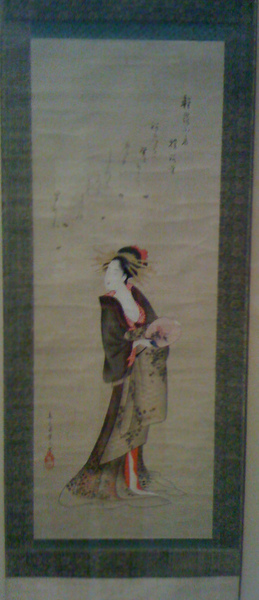
- Born: 1756
- Died: 1829
- Other Names: 細田時富 (Hosoda Tokitomi)[1], 細田栄之 (Hosoda Eishi)
- Japanese: 鳥文斎 栄之 (Choubunsai Eishi)
Chôbunsai Eishi, also known as Hosoda Eishi, was an ukiyo-e painter and print designer, known primarily for his depictions of tall, thin, graceful beauties.
The eldest son of a local Edo samurai official of the Hosoda family, Eishi studied under Kanô Michinobu, and served as an official court painter to the shogunate for a number of years. He held hatamoto rank and had an income of 500 koku. His art-name, Eishi, was granted him by the shogun Tokugawa Ieharu himself. Chôbunsai is likewise a pseudonym, a studio name, using the character sai (斎) in its meaning of "studio," much as did the artists Hokusai, Kôryûsai, Keisai Eisen and Ichiryûsai Hiroshige.
In the mid-1780s, however, Eishi made a dramatic change, and moved from the realm of elite painting to ukiyo-e. After working on illustrations for kibyôshi for several years, in 1789, he began producing ukiyo-e works in earnest, including single-sheet prints and paintings. His style shows influence from Utamaro, Torii Kiyonaga and others, but bears distinctive elements as well. Eishi's women are tall and slender, a continuation and development of a trend begun by Utamaro and Kiyonaga, and they bear a refinement and grace rarely exceeded by the figures in bijinga by other artists.
Around 1798, he quit print designs, and turned his attention more fully to painting. It is said that one of his handscrolls, depicting scenes along the Sumidagawa, so impressed the wealthy patrons for whom it was painted that they presented it at a special showing to the Imperial family. This was an especially rare honor for a plebian ukiyo-e piece, one which perhaps no other ukiyo-e artist ever enjoyed.
Though Eishi never formally established a school and trained but a few direct pupils, ukiyo-e connoisseur Richard Lane identifies a number of artists who followed in Eishi's footsteps, describing them as "among the most fascinating secondary figures in ukiyo-e history"[2]. They include Eishôsai Chôki, Chôkôsai Eishô, Rekisentei Eiri, Chôkyôsai Eiri, and Ichirakutei Eisui.
References
- Lane, Richard. Images from the Floating World. New York: Konecky & Konecky, 1978. pp141-145.
- Morse, Anne Nishmura et al. The Allure of Edo: Ukiyo-e Painting from the Museum of Fine Arts, Boston (江戸の誘惑: ボストン美術館所蔵 肉筆浮世絵展, Edo no yûwaku: Bosuton bijutsukan shozô nikuhitsu ukiyoe ten). Tokyo: Asahi Shimbun-sha, 2006. pp185-186.
- ↑ Kobayashi Tadashi et al. Ukiyo-e: an introduction to Japanese woodblock prints. Kodansha International, 1997. p85.
- ↑ Lane. p142.